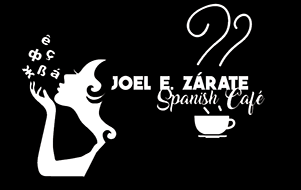Unit 1: Grammar
Grammar Points for This Unit
In this section, I will go over the important grammar points that you need to know for the unit.
1) Subject Pronouns (Yo, Tú, Él)
In Spanish to say "I", we use the subject pronoun "yo". Yo = I
"Tú" is the pronoun that we use for "You", but "you" in English can be singular or can be plural.
"Tú" is a pronoun that we use with friends, family and people that you feel close to, people that tell you to treat them as friends.
"Tú" it's NOT used in formal situations.
"Él" is the pronoun for "He".
In sum:
Yo = I
Tú = You (singular, for friends, family, informal situations)
Él = He
2) Verbs
What are verbs?
Verbs are the part of speech, the words, that indicate an action, an activity or an state of being of a subject. Generally, in a sentence, we have a subject and verb.
Examples
Subject + Verb + (complement)
I speak (Spanish)
John eats (vegetables)
My wife and I live (in California)
John is (a teacher)
3) Verbs in Spanish
In Spanish, we have 3 types of verbs, and we categorize these verbs by their ending.
These are the 3 categories of verbs:
- Those ending in (-ar)
- Those ending in (-er)
- Those ending in (-ir)
Some verbs ending in (-ar)
- Hablar = to speak
- Estudiar = to study
- Enseñar = to teach
Some verbs ending in (-er)
- Comer = to eat
- Aprender = to learn
- Beber = to drink
Some verbs ending in (-ir)
- Vivir = to live
- Abrir = to open
- Escribir = to write
4) Conjugating in the Present Tense for: Yo, Tú & Él
In Spanish, we conjugate verbs by removing the ending that I mentioned earlier. Once we remove this ending, the we can add the ending that corresponds to the subject.
We have regular verbs and irregular verbs.
Regular verbs follow the same pattern, but irregular verbs show an additional change. Most of the verbs in Spanish are regular, but a handful of irregular verbs are commonly used verbs in Spanish. You'll learn these irregular verbs as needed in future units.
Conjugating for "Yo" in the Present Tense
All regular verbs (the 3 categories) share the same ending for "yo" and that ending is (-o). To conjugate, we remove the verb ending, and we add the new ending that corresponds to the subject, in this case (-o) for "yo".
Examples
- Hablar -> habl -> hablo
Yo hablo - Comer -> com -> como
Yo como - Vivir -> viv -> vivo
Yo vivo
Conjugating for "Tú" in the Present Tense
Verbs ending in (-er) and (-ir) share the same ending (-es). We use that to conjugate for "tú"; however, (-ar) ending verbs have the ending (-as) to conjugate the verbs.
Examples
- Hablar -> habl -> hablas
Tú hablas - Comer -> com -> comes
Tú comes - Vivir -> viv -> vives
Tú vives
Conjugating for "Él" in the Present Tense
Él is the same as tú, (-er) and (-ir) verbs, share the same ending, and (-ar) verbs have a differet ending.
So for (-er) and (-ir) we simply add, (-e) and, (-ar) ending verbs have the ending (-a) to conjugate the verbs.
Examples
- Hablar -> habl -> habla
Él habla - Comer -> com -> come
Él come - Vivir -> viv -> vive
Él vive
In sum:
- Yo hablo, tú hablas, él habla
- Yo como, tú comes, él come
- Yo vivo, tú vives, él vive
Note: In Spanish, we don't need to have the subject pronoun. We usually omit it when we are speaking.
5) Estar & Ser = to be
As I mentioned before, we have regular verbs and irregular verbs, most verbs are regular, but there are a handful of commonly used verbs that are irregular. Ser and Estar are considered irregular.
In the future, I am going to do a unit specifically for Ser & Estar because they are very important verbs, but I want to mention them because to say, “how are you (singular)?”, we say, “¿Cómo estás? and to answer, “I’m fine”, we say, “estoy bien”. So, you are going to hear that in the modules as I welcome my guest.
In very simple terms, Ser is used to indicate who you are, what you're like, where you are from: For example, I am a teacher, I am Mexican, I am a good person, etc. So in the last modules, you’ll also hear ser for I and for He as Milton says who he is and as we talk about Milton in the 3rd person.
In a future unit, you will learn in more detail about ser and estar.
6) Simple Present & Present Progressive in Spanish
In Spanish, we can use the simple present and presen progressive to talk about something that we are doing right.
The Simple Present
Routines, activites or actions that we do on a regular basis in our everyday life.
I study, I clean, I eat, I do the dishes in the morning, I take a shower in the morning.
The Present Progressive
Refers to something that you are doing right now.
I am studying, I am cleaning, I am eating, I am doing the dishes, etc.
In Spanish, I could say:
Ejemplo 1
- Joel: María, ¿qué haces? (Literally: what do you do?)
- María: Preparo la comida. (Literally: I prepare the food?) or
María: Estoy preparando la comida (Literally, I am preparing the food)
Ejemplo 2
- Joel: Alba, ¿qué lees? (Literally: what do you read?)
- Alba: Leo un libro de misterio. (Literally: I read a book of mistery).
Alba: Estoy leyendo un libro de misterio. (Literally: I am reading a book of mistery).
